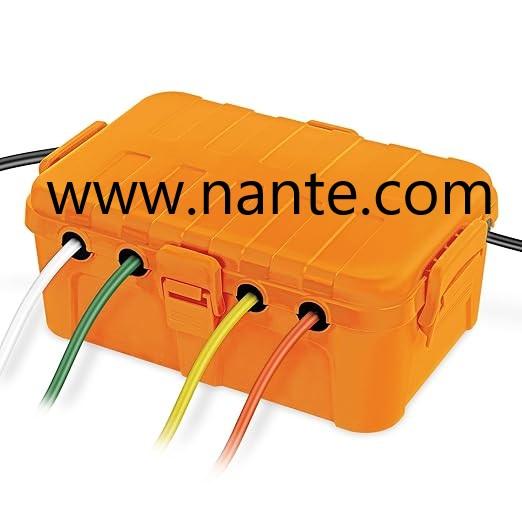Can Nante outdoor enclosures reduce trip hazards around public event areas

When designers aim to keep exterior spaces tidy and safe while still offering convenient power, an Outdoor Socket Box often becomes the go to choice for patios stages and temporary service zones. A well planned enclosure hides wiring, shields contacts from weather and provides a predictable access point for technicians and event staff. In a landscape where rainy seasons and unplanned activations put pressure on venues, careful selection and installation make a practical difference to safety and daily operation.
Start by thinking about placement strategy. Locating the unit where it is reachable for authorized staff yet not exposed to heavy pedestrian flow reduces accidental contact and trampling. Mounting near fixed elements such as posts or low walls keeps cable runs neat and lets team members route cords along planned lines. Placing the enclosure slightly recessed or behind a planting bed softens its visual presence while keeping connectors accessible when needed.
Cable entry deserves attention from the first step. Use glands sized to the conductor bundle and route cables with gentle curves so terminations do not suffer stress. Fixing points that anchor conductors outside the terminal zone reduce mechanical load on screw heads and prevent repeated retorque work. When cables enter cleanly and remain stable, crews report fewer surprises during routine checks and the overall upkeep load drops.
Sealing and water management matter more than many expect. A closure that sheds rain and that prevents dripping into the interior protects insulating parts and keeps protective devices functioning as designed. Where washing or hosedown happens nearby plan drainage paths that divert runoff away from the enclosure base. That practice makes cleaning safer for staff and limits the chance that contaminants reach internal parts during maintenance.
Grounding and equipment bonding are essential at outdoor sites. A robust earthing arrangement gives the enclosure a clear return path and helps protective devices act when a fault appears. Secure bonding connections and visible earth tags assist technicians during inspections and speed fault diagnosis. When grounding is straightforward crews spend less time chasing ambiguous leak paths and more time verifying that protective devices have cleared properly.
Access control reduces casual interference. A lockable cover or a keyed access flap keeps connectors out of reach of visitors and non technical helpers. Permit holders and on site supervisors can maintain oversight while volunteers and contractors carry out permitted tasks. Controlled entry helps when many teams share a location and when rapid handovers occur during festivals and markets.
Consider thermal behavior inside the case. Allow room around heat producing elements and avoid tight clustering of current carrying parts. Ventilation slots and internal spacing help dissipate warmth and reduce internal stresses on components. That approach lowers the chance of thermal related deterioration that would otherwise increase maintenance frequency for crews who manage many assets across busy precincts.
Labeling and internal diagrams simplify handovers. Durable legends and a small wiring map inside the cover fast track isolation steps and lower the risk of accidental re energizing. Clear markings help visiting contractors and seasonal staff act consistently and reduce the number of calls that require senior electricians to perform simple routine tasks.
Protective accessories reduce wear. Use inlet caps and outlet covers that remain attached to the unit so protective elements do not get lost during service. Strain relief collars and protective sleeves at contact points prevent abrasion where cables bend. These small details keep connectors happy over more cycles and reduce the volume of reactive repairs that disrupt programming and service.
Inspection rhythm and simple checklists pay off. Short pre use checks that confirm cover seating clamp torque and indicator behavior catch small issues before busy periods. Teams that adopt quick verification steps find they avoid late night calls and that planned replacements fit more neatly into routine windows rather than into emergency sequences.
Human factors can make the difference when conditions are busy. Design the opening motion and the latch so that a single person can access the interior safely while holding a lamp or while communicating with a colleague. Ergonomic touches that let crews operate quickly under pressure reduce errors and speed service windows during events where time is tight.
Transport and storage are practical concerns for multi site operators. Choose a model that nests or that stacks cleanly so vehicle space is efficient. Durable corners and protected latches reduce the chance of transit damage and minimize time spent repairing cosmetic knocks before an installation day.
When procurement weighs options, ask about spare parts and accessory availability. Choosing a family of enclosures with shared glands caps and mounting plates reduces inventory complexity and helps maintenance teams keep units running across many locations. Standardized accessories let technicians swap common wear items on site and return equipment to service without delays.
A short on site trial before committing fleet wide is often worthwhile. Testing a candidate under real handling patterns and with actual cable layouts reveals small fit issues that drawings may miss. Mockup checks reduce surprises during the first major event and give frontline staff confidence in the handling routines.
For planners and technicians ready to compare models, mounting kits and accessory options, check the manufacturer product listings and guidance at https://www.nante.com/product/ . The resources include imagery and configuration notes that help align choice with site demands and with maintenance capabilities so that installations remain safe and tidy across many service cycles.





